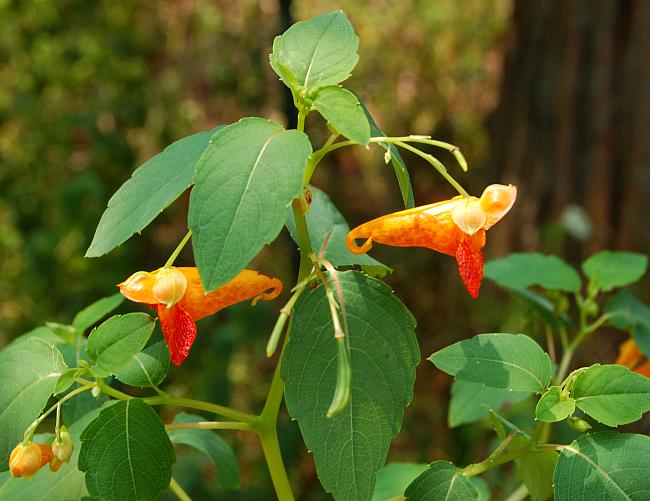Impatiens capensis Meerb.
Jewelweed

Native
CC = 3
CW = -3
MOC = 84
© SRTurner
Impatiens capensis Meerb.Jewelweed | |
 |
Native CC = 3 CW = -3 MOC = 84 |
© SRTurner |
|
Family - Balsaminaceae Habit - Annual forb. Stems - Ascending to erect, to 1.5 m, usually branched, succulent, glabrous, somewhat glaucous, hollow when larger.
Leaves - Alternate, simple, petiolate. Petiole to 5 cm long, glabrous. Blades to 22 cm long, ovate to elliptic, narrowed or tapered at the base, narrowed to the pointed tip, the margins coarsely to finely scalloped or bluntly toothed, the teeth usually ending in whitish mucros, the basal portion sometimes with few to several small-stalked, dark-colored glands, the undersurface somewhat glaucous.
Inflorescences - Solitary flowers or more commonly of small panicles of 2-5 flowers from leaf axils, these orange or rarely cream-colored to white, with abundant red to reddish brown spots. Pedicels to 3 cm long, sometimes with one or two small scale-like bracts.
Flowers - Sepals 3, the apparent lowest one petaloid and inflated into a conical pouch 12-22 mm long and about twice as long as wide, this tapered to a slender, recurved nectar-producing spur 7-10 mm long, the two lateral sepals 2-7 mm long, free, somewhat cupping the flower, broadly ovate, tapered abruptly to a pointed tip, and green or pale-colored. Petals 5, but appearing as 3, each of the 2 apparent lateral ones lobed, representing a fused pair, the single apparently upper petal free, wider than long, and keeled. Stamens 5, the filaments short and flat, fused toward the tips, each with a scalelike appendage on the inner side, these appendages fused into a cap over the pistil, the short, stout anthers often also somewhat fused, the whole complex of stamens and cap shed as a unit before the stigmas mature. Pistil 1 per flower, of 5 fused carpels, the ovary superior, 5-locular, the placentation axile. Ovules 3 to many per locule. Style absent or very short, the stigmas 5, minute.
Fruits - Capsules 1.4-2.0 cm long, elliptic to oblanceolate in outline, violently dehiscent when mature. Seeds 4-5 mm long, elliptic-ovate in outline, the tip nipplelike or beaklike, strongly and irregularly 4-angled, the surface with a network of low ridges in several irregular columns, sometimes appearing irregularly warty, dark brown.
Flowering - June - September. Habitat - Bottomland forests, swamps, sloughs, streambanks, ravines, moist disturbed areas. Origin - Native to the U.S. Lookalikes - Unmistakable when flowering. Vegetatively resembles I. pallida. Other info. - This plant is common across Missouri, probably occurring somewhere in nearly every county. It is also common across the eastern half of the continental U.S., with a disjunct appearance in the Pacific Northwest. The plant is one of the most easily identified of Missouri's natives, with the curiously shaped flowers a dead giveaway. It is also easily recognized vegetatively, with a little practice. The foliage is very similar to that of I. pallida, but that species has leaves with more than 9 teeth per side. Photographs taken in Brown Summit, NC., 7-15-02 (DETenaglia); also at Shaw Nature Reserve, Franklin County, MO, 8-12-2006, along the Katy Trail near Dutzow, Warren County, MO, 8-10-2014 and 9-04-2015, and along the Al Foster Trail near Glencoe, St. Louis County, MO, 9-09-2021 (SRTurner). |